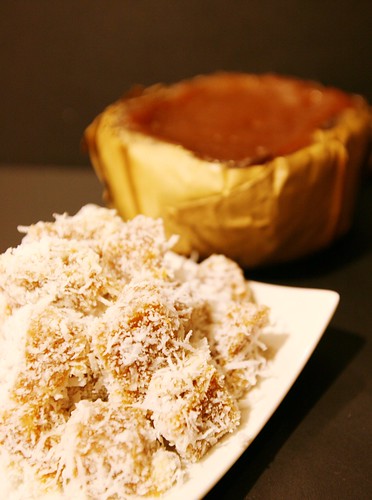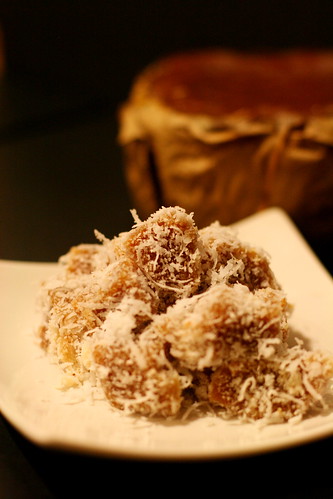 Let us kick start the Chinese new year season with this traditional sticky cake.
Let us kick start the Chinese new year season with this traditional sticky cake.When we start getting this special cake, we know for sure the season of Chinese new year is here. This dessert is synonymous with CNY as fruit cake is to Christmas. It is a must-have in all Chinese households during this festive season.
Chinese love auspicious sounding food during this most important season of the year. Nian Gao has the same connotation of 年高, which literally is 'year high' - means something like getting higher in the year. When this cake is given as a gift, it brings with it the wish that everything in the year will improve and get better (higher).
An old legend related to this dessert is that the Kitchen God is fed with this cake. The stickiness of the cake would glue the Kitchen God's mouth and that, hopefully will prevent him from reporting anything unfavourable about the family in heaven.
This cake is seldom eaten as is but can be prepared in many different ways.
The simplest method and the way my mum liked it best is to pan-fry thin slices of the cake coated in beaten eggs until soft and golden.
My children like it deep-fried, sandwiched between two slices of yam (taro) dipped in a light batter.
The dessert above is my favourite way to eat this cake. Steam the cake till soft. If the cake is freshly made omit the steaming. Cut it into bite-size cubes with a thick thread and roll the cubes in freshly grated coconut. Simpl yet so delicious.
Pit Fung gave us the above cake specially ordered from a lady who makes it every year. The texture is unbelievably smooth and it is also kurang manis (less sugar). It is wrapped in banana leaves which gives it a very alluring aroma.
Traditionally, nian gao is made of only a few basic ingredients - just glutinous rice flour, sugar and water. Mix them together well and knead. Divide the dough, place in lined (with fragrant leaves like banana, lotus, pandan or like those we get in the shops - just cellophane) containers and steam for 3-4 hours. Depending on the sugar content in the cake, some can be safely kept for days without refrigeration or months in fridge.
My grandparents used to make these cakes in the olden days to sell .
They made them from scratch. Started with the grinding of soaked glutinous rice in a hugh stone grinder.
2 hugh cylindrical slabs of stone, one piled on top of the other. The top slab has a hole in the centre and a handle with which to move the stone that required a lot of muscles to turn.
One hand spoon the soaked glutinous rice into the hole and the other hand would turn the stone in a circular path. The grinding takes place between the two slabs of stones and the final produce comes out in a milky solution.
The ground rice would then be tied into a bag and hang to drain out some of the water used to ground the rice.
They also used the same machine for grinding soy beans for tofu making. I am biased I know, but then, everything used to taste so much better - my grandparents made the best tofu I have ever tasted. Silky smooth with the most exquisite smoky aroma.
Cooking with firewood is something we have sacrificed for convenience
I remember the hustle and bustle in the kitchen at the back of the shop house (they lived upstairs in the shop) a month or so before Chinese new year with rows and rows of metal containers lining up to be filled and steamed.
A gigantic triple story bamboo steamer atop a big wok that sat on a hugh furnace fed with fire wood working non-stop and the aroma that filled the kitchen was intoxicating.
If you are still with me, thank you for putting up with my memory lane ramblings . Our grandparents are no more here but the fond memories they left behind are sometimes still so vivid!
Better stop here and leave you with these sweetness before I get started on a novel...
An old legend related to this dessert is that the Kitchen God is fed with this cake. The stickiness of the cake would glue the Kitchen God's mouth and that, hopefully will prevent him from reporting anything unfavourable about the family in heaven.
This cake is seldom eaten as is but can be prepared in many different ways.
The simplest method and the way my mum liked it best is to pan-fry thin slices of the cake coated in beaten eggs until soft and golden.
My children like it deep-fried, sandwiched between two slices of yam (taro) dipped in a light batter.
The dessert above is my favourite way to eat this cake. Steam the cake till soft. If the cake is freshly made omit the steaming. Cut it into bite-size cubes with a thick thread and roll the cubes in freshly grated coconut. Simpl yet so delicious.
Pit Fung gave us the above cake specially ordered from a lady who makes it every year. The texture is unbelievably smooth and it is also kurang manis (less sugar). It is wrapped in banana leaves which gives it a very alluring aroma.
Traditionally, nian gao is made of only a few basic ingredients - just glutinous rice flour, sugar and water. Mix them together well and knead. Divide the dough, place in lined (with fragrant leaves like banana, lotus, pandan or like those we get in the shops - just cellophane) containers and steam for 3-4 hours. Depending on the sugar content in the cake, some can be safely kept for days without refrigeration or months in fridge.
My grandparents used to make these cakes in the olden days to sell .
They made them from scratch. Started with the grinding of soaked glutinous rice in a hugh stone grinder.
2 hugh cylindrical slabs of stone, one piled on top of the other. The top slab has a hole in the centre and a handle with which to move the stone that required a lot of muscles to turn.
One hand spoon the soaked glutinous rice into the hole and the other hand would turn the stone in a circular path. The grinding takes place between the two slabs of stones and the final produce comes out in a milky solution.
The ground rice would then be tied into a bag and hang to drain out some of the water used to ground the rice.
They also used the same machine for grinding soy beans for tofu making. I am biased I know, but then, everything used to taste so much better - my grandparents made the best tofu I have ever tasted. Silky smooth with the most exquisite smoky aroma.
Cooking with firewood is something we have sacrificed for convenience
I remember the hustle and bustle in the kitchen at the back of the shop house (they lived upstairs in the shop) a month or so before Chinese new year with rows and rows of metal containers lining up to be filled and steamed.
A gigantic triple story bamboo steamer atop a big wok that sat on a hugh furnace fed with fire wood working non-stop and the aroma that filled the kitchen was intoxicating.
If you are still with me, thank you for putting up with my memory lane ramblings . Our grandparents are no more here but the fond memories they left behind are sometimes still so vivid!
Better stop here and leave you with these sweetness before I get started on a novel...
 Jo
Jo

7 comments:
I just love the salty sweet taste of eating the Nian Gao with the coconut like this! :o)
Yumz, tts all i had for dinner tt night - the dessert! Once started couldn't stop :p
Awww..this Nian Gao look so delicious...u reminded me Chinese New Year are coming soon :)
Honk!honk! CNY is just round the corner...start dishing out all ur new year's goodies to share :o)
This is good stuff. You're pulling out all the childhood memories out of my memory bank :)
I am definitely going to either a. Bug my mom to cook me some. or b. Bug Iris to cook me some.
Either way I am off to bug someone :) hehehe.
Cheers
bad influence, eh? Sorry, Iris.
nice shots. I can't wait to get home for some nian gou! Love the sticky kind!
Post a Comment